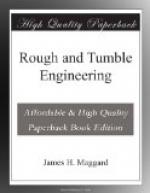TINKERING ENGINEERS
After carelessness, meddling with an engine comes next in the list of bad habits. The tinkering engineer never knows whether his engine is in good shape or not, and the chances are that if he should get it in good shape he would not know enough to let it alone. If anything does actually get wrong with your engine, do not be afraid to take hold of it, for something must be done, and you are the one to do it, but before you do anything be certain that you know what is wrong. For instance, should the valve become disarranged on the valve stem or in any other way, do not try to remedy the trouble by changing the eccentric, or if the eccentric slips do not go to the valve to mend the trouble. I am well aware that among young engineers the impression prevails that a valve is a wonderful piece of mechanism liable to kick out of place and play smash generally. Now let me tell you right here that a valve (I mean the ordinary slide valve, such as is used on traction and portable engines), is one of the simplest parts of an engine, and you are not to lose any sleep about it, so be patient until I am ready to introduce you to this part of your work. You have a perfect right to know what is wrong with the engine. The trouble may not be so serious and it is evident to you that the engine is not running just as nicely as it should. Now, if your engine runs irregularly, that is if it runs up to a higher speed than you want, and then runs down, you are likely to say at once, “Oh I know what the trouble is, it is the governor.” Well, suppose it is, what are you going to do about it, are you going to shut down at once and go to tinkering with it? No, don’t do that, stay close to the throttle valve and watch the governor closely. Keep your eye on the governor stem, and when the engine starts off on one of its high speed tilts, you will see the stem go down through the stuffing box and then stop and stick in one place until the engine slows down below its regular speed, and it then lets loose and goes up quickly and your engine lopes off again. You have now located the trouble. It is in the stuffing box around the little brass rod or governor stem. The packing has become dry and by loosening it up and applying oil you may remedy the trouble until such time as you can repack it with fresh packing. Candle wick is as good for this purpose as anything you can use.
But if the governor does not act as I have described and the stem seems to be perfectly free and easy in the box, and the governor still acts queerly, starting off and running fast for a few seconds, and then suddenly concluding to take it easy and away goes the engine again, see if the governor belt is all right, and if it is, it would be well for you to stop and see if a wheel is not loose. It might be either the little belt wheel or one of the little cog wheels. If you find these are all right, examine the spool




